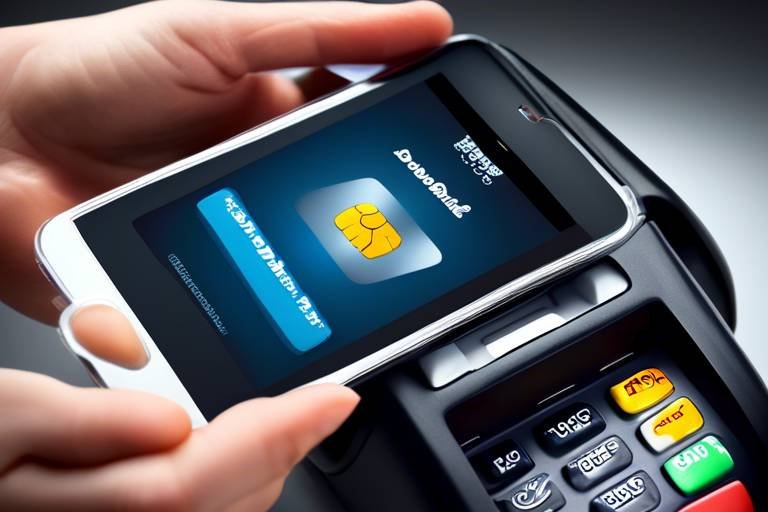The Future of Mobile Payment Solutions
The world of mobile payment solutions is rapidly evolving, and the future looks brighter than ever. With the advent of innovative technologies and a growing reliance on digital transactions, consumers and businesses alike are embracing this transformation. Imagine a world where you can pay for your morning coffee with just a tap of your phone, or where sending money to a friend is as simple as sending a text message. This is not just a dream; it's becoming our reality. As we delve into the intricacies of mobile payments, we'll explore the technological advancements driving this change, the shifting user preferences, and the security challenges that come along with it.
Technological innovations are at the heart of the mobile payment revolution. From NFC (Near Field Communication) to QR codes and blockchain technology, these advancements are enhancing user experiences and transaction efficiencies. NFC technology allows users to make payments by simply tapping their devices at a point of sale, while QR codes offer a quick and easy way to complete transactions through scanning. Blockchain, on the other hand, introduces an unprecedented level of security and transparency, paving the way for a more trustworthy payment ecosystem. As these technologies continue to evolve, they will not only streamline the payment process but also encourage broader adoption across various sectors, including retail, hospitality, and transportation.
Understanding user preferences is crucial for mobile payment providers. Consumers today are looking for convenience, security, and seamless integration with their digital lives. The modern shopper is tech-savvy and expects to have multiple payment options at their fingertips. Factors such as user interface, transaction speed, and customer support play significant roles in influencing consumer adoption. As mobile wallet options become more prevalent, users are increasingly favoring solutions that offer a blend of functionality and ease of use. This shift in consumer behavior is not just a trend; it’s a clear indication that businesses must adapt to stay relevant in the competitive digital economy.
One of the most significant trends in mobile payments is the rise of contactless payments. The convenience of simply tapping a device to make a payment has captured the hearts of consumers. This method not only speeds up the transaction process but also enhances the overall shopping experience. Retailers are seeing the benefits of adopting contactless payment systems, as they can serve more customers quickly, thereby increasing sales and customer satisfaction. However, this shift also requires retailers to upgrade their point-of-sale systems to accommodate these technologies, which can be both a challenge and an opportunity.
As contactless payments gain traction, retailers are adapting by investing in newer technology. The benefits are clear: faster transactions, reduced wait times, and improved customer satisfaction. However, the transition is not without its challenges. Retailers must navigate the costs associated with upgrading systems and training staff. Yet, the long-term advantages of enhanced customer loyalty and increased sales often outweigh these initial hurdles. In a world where convenience is king, businesses that embrace contactless payments are likely to thrive.
With the rise of contactless payments, consumer behavior is undergoing a significant transformation. Shoppers are now more inclined to spend when they can pay quickly and effortlessly. This shift not only impacts spending habits but also influences overall satisfaction with mobile payment solutions. As consumers become accustomed to the speed and ease of contactless payments, they may also become more open to exploring other digital payment options, further driving the evolution of mobile payments.
While the convenience of mobile payments is undeniable, they also present security challenges. As more transactions move online, the risk of fraud and data breaches increases. It's crucial for consumers and businesses to understand the vulnerabilities associated with mobile transactions. To mitigate these risks, payment providers are investing in advanced security measures such as biometric authentication, tokenization, and end-to-end encryption. These technologies aim to protect sensitive information and build trust among users, ensuring a safer mobile payment environment.
The integration of mobile payment solutions with e-commerce platforms is transforming online shopping experiences. Customers now expect seamless payment options that enhance their shopping journey. When payment processes are smooth and intuitive, customer satisfaction skyrockets, leading to increased sales and repeat business. E-commerce platforms that prioritize mobile payment integration are likely to see a significant boost in customer loyalty and overall revenue.
Emerging trends in e-commerce payments, such as subscription models and pay-later options, are reshaping how consumers approach online transactions. These models provide flexibility and convenience, allowing consumers to manage their finances better. As these trends gain traction, they will likely have a profound impact on the market, influencing both consumer behavior and business strategies.
Cryptocurrencies are increasingly being integrated into mobile payment solutions, offering unique advantages such as lower transaction fees and enhanced security. As digital currencies gain acceptance, they could revolutionize the way we conduct transactions. However, challenges such as volatility and regulatory compliance must be addressed to ensure widespread adoption. The future of cryptocurrencies in mobile payments is promising, yet it requires careful navigation of these complexities.
While cryptocurrency payments offer numerous benefits, including speed and security, they also pose challenges. The inherent volatility of cryptocurrencies can deter some consumers, while regulatory uncertainties can complicate their use in mobile payments. As the landscape evolves, it's essential for stakeholders to stay informed and adapt to these changes to harness the full potential of cryptocurrencies in the mobile payment space.
- What are mobile payment solutions? Mobile payment solutions are digital platforms that allow consumers to make transactions using their mobile devices, typically through apps or digital wallets.
- Are mobile payments safe? While mobile payments offer convenience, they can present security challenges. However, many providers implement advanced security measures to protect users' information.
- How do contactless payments work? Contactless payments use technologies like NFC to enable users to make transactions by simply tapping their devices at a point of sale.
- What is the future of cryptocurrencies in mobile payments? Cryptocurrencies are expected to play a growing role in mobile payments, but challenges such as volatility and regulatory compliance must be addressed for widespread adoption.

Technological Advancements in Mobile Payments
The world of mobile payments is undergoing a remarkable transformation, driven by cutting-edge technologies that are reshaping how we conduct transactions. Innovations such as NFC (Near Field Communication), QR codes, and blockchain technology are at the forefront of this evolution, enhancing user experience and boosting transaction efficiency. But what does this mean for you, the everyday consumer? Let’s dive into these advancements to understand their impact on our daily lives.
At the heart of mobile payment solutions lies NFC technology. This nifty feature allows devices to communicate with one another when placed within close proximity. Imagine walking into a coffee shop, pulling out your phone, and simply tapping it on a reader to pay for your morning brew. It’s quick, it’s easy, and it’s becoming the norm. This technology not only speeds up transactions but also minimizes the need for physical cash or cards, making it a game-changer in the retail landscape.
On the other hand, QR codes have become increasingly popular, especially in regions where smartphone penetration is high. They allow users to scan a code with their phone's camera to complete a payment. This method is not just limited to retail; it’s also being used in restaurants, events, and even for donations. The beauty of QR codes is their versatility and low-cost implementation. You don’t need fancy hardware—just a smartphone and a printed code!
Now, let’s talk about blockchain technology, which is often associated with cryptocurrencies but has far-reaching implications for mobile payments. By providing a decentralized and secure method of recording transactions, blockchain technology enhances the security and transparency of mobile payments. Imagine a world where every transaction is verified and recorded, reducing the risk of fraud and ensuring that your data remains private. This technology is paving the way for a more secure digital economy, where trust is built into the system itself.
As we look at these advancements, it’s crucial to recognize that they are not just about technology; they are about enhancing user experience. Consumers today demand convenience and speed. They want to complete transactions in a matter of seconds, without the hassle of carrying cash or fumbling with cards. Mobile payment solutions are rising to meet these expectations, creating a seamless experience that integrates with our fast-paced lifestyles.
However, the rapid evolution of mobile payments also raises important questions about security. While technologies like NFC and blockchain offer enhanced security features, vulnerabilities still exist. Cybersecurity threats are becoming more sophisticated, and users must remain vigilant. Mobile payment providers are continuously working to address these concerns, implementing measures such as two-factor authentication and encryption to protect users’ financial information.
In conclusion, the technological advancements in mobile payments are not just reshaping how we transact; they are redefining our relationship with money. As we embrace these innovations, it’s essential to stay informed and adapt to the changes they bring. The future of mobile payments is bright, and it’s up to us to navigate this exciting landscape.

User Preferences and Adoption Trends
In the fast-paced world of mobile payments, understanding user preferences is crucial for providers aiming to capture a significant market share. Consumers today are not just looking for a way to pay; they seek an experience that is seamless, secure, and tailored to their lifestyle. The factors influencing consumer adoption of mobile payment solutions can be boiled down to a few key elements: convenience, security, and integration with other digital services.
Convenience is king in our busy lives. Imagine walking into a store, grabbing your items, and simply tapping your phone to pay—no fumbling for cash or cards. This is the reality that mobile payment solutions provide. According to recent surveys, a staggering 75% of consumers prefer using mobile wallets over traditional payment methods due to the speed and ease of use. This shift is not just a trend; it's a fundamental change in how we interact with money.
Security is another major concern for consumers. With the rise of digital transactions, the fear of fraud and data breaches looms large. Mobile payment providers are responding to these concerns by implementing advanced security measures such as biometric authentication, tokenization, and encryption. In fact, a recent study found that 80% of users feel more secure using mobile payments when these technologies are in place. This growing confidence is driving adoption rates higher than ever.
Moreover, the integration of mobile payment solutions with other digital services is reshaping consumer expectations. People want their payment methods to work seamlessly with their shopping experiences, whether online or in-store. For instance, mobile wallets that integrate loyalty programs or offer instant discounts are particularly appealing. A recent survey indicated that 65% of consumers are more likely to use a mobile payment solution that offers rewards or discounts, showcasing the importance of added value in driving adoption.
As we delve deeper into the realm of mobile payments, one trend stands out: the meteoric rise of contactless payments. The convenience of simply tapping your phone or card at a terminal has captured the hearts of consumers everywhere. This method not only speeds up the transaction process but also minimizes physical contact—a significant consideration in today's health-conscious environment. Retailers are taking note, and many are upgrading their point-of-sale systems to accommodate this growing consumer preference.
Retailers are not just passive observers in this evolution; they are actively adapting to meet consumer demands. Upgrading point-of-sale systems to support contactless payments can be a daunting task, but the benefits far outweigh the challenges. With contactless payments, retailers can enhance the customer experience, reduce wait times, and ultimately drive higher sales. However, they must also navigate the challenges of implementation, including costs and staff training. The potential for increased customer satisfaction and loyalty makes this investment worthwhile.
As contactless payments become mainstream, we are witnessing a notable shift in consumer behavior. The ease and speed of these transactions are altering spending habits; customers are more likely to make impulse purchases when the payment process is simplified. This change not only affects how much consumers spend but also their overall satisfaction with mobile payment solutions. A satisfied customer is more likely to return, creating a positive feedback loop that benefits both consumers and retailers alike.
In summary, the landscape of mobile payments is rapidly evolving, driven by user preferences that prioritize convenience, security, and integration. As we move forward, understanding these trends will be essential for businesses looking to thrive in the digital economy.
- What are mobile payment solutions? Mobile payment solutions allow users to make transactions using their smartphones or other mobile devices, providing a convenient alternative to traditional payment methods.
- How secure are mobile payments? Mobile payments are generally secure, employing technologies like encryption and biometric authentication to protect user data.
- Why are contactless payments becoming popular? Contactless payments offer a quick and convenient way to transact, reducing wait times and minimizing physical contact.
- What should retailers consider when adopting mobile payments? Retailers must consider the cost of upgrading systems, staff training, and the potential for increased customer satisfaction and sales.

The Rise of Contactless Payments
In recent years, contactless payments have surged in popularity, transforming the way we conduct transactions. Imagine walking into a store, grabbing what you need, and simply tapping your card or smartphone on a reader to complete the purchase. This level of convenience is not only appealing but has become a preferred method for many consumers. With the hustle and bustle of modern life, who has time to fumble with cash or wait for a chip card to process? The speed and simplicity of contactless transactions are reshaping our shopping experiences.
According to a recent study, over 60% of consumers now prefer contactless payment methods. This trend is driven by several factors:
- Speed: Transactions are completed in seconds, reducing wait times at checkout.
- Convenience: No need to carry cash or search for your card; just tap and go!
- Hygiene: In a post-pandemic world, minimizing physical contact has become a priority for many.
Retailers are taking notice of this shift. They are upgrading their point-of-sale systems to accommodate these quick payment options. But it's not just about keeping up with trends; it's about enhancing the customer experience. For instance, many stores now feature contactless payment terminals prominently at checkout, making it clear that they embrace this innovative technology. This adaptation not only speeds up transactions but also encourages more customers to choose contactless options.
However, the rise of contactless payments is not without its challenges. Retailers must invest in new technology and train staff to handle these systems efficiently. Additionally, they need to ensure that their infrastructure can support the increased volume of transactions that contactless payments can generate. Despite these hurdles, the benefits far outweigh the costs, and businesses that embrace this technology are likely to see a significant boost in customer satisfaction and loyalty.
Moreover, as contactless payments become mainstream, they are influencing consumer behavior in profound ways. People are spending more freely and often because the ease of tapping to pay removes some of the psychological barriers associated with spending. This shift in behavior can be likened to the introduction of online shopping: once consumers experienced the convenience, there was no going back. Retailers must adapt to this new consumer mindset to thrive in the evolving marketplace.
In conclusion, the rise of contactless payments is not just a fleeting trend but a fundamental shift in how we handle transactions. As technology continues to advance, we can expect even more innovations in this space. The future is bright for contactless payments, promising a seamless, efficient, and user-friendly payment experience that benefits both consumers and retailers alike.

Impact on Retailers
The rise of contactless payments is not just a trend; it's a revolution in how retailers conduct business. As consumers increasingly prefer the convenience and speed of tapping their cards or smartphones at checkout, retailers are feeling the pressure to adapt. This shift is not merely about keeping up with consumer preferences; it's about survival in a competitive market. Retailers who embrace these technologies can enhance the shopping experience, streamline operations, and ultimately drive sales.
One of the most significant impacts on retailers is the need to upgrade their point-of-sale (POS) systems. Traditional cash registers are becoming obsolete, replaced by modern systems that can handle various payment methods, including mobile wallets and contactless cards. This transition requires an initial investment, but the long-term benefits can be substantial. For instance, retailers can expect:
- Increased Transaction Speed: Contactless payments can reduce checkout times, leading to shorter lines and improved customer satisfaction.
- Enhanced Customer Experience: By offering multiple payment options, retailers can cater to diverse consumer preferences, making shopping more enjoyable.
- Improved Inventory Management: Modern POS systems often come with integrated inventory management tools, helping retailers keep track of stock levels in real-time.
However, the transition isn’t without its challenges. For many small to medium-sized retailers, the cost of upgrading technology can be daunting. They might find themselves torn between investing in new systems and maintaining their current operations. Furthermore, there’s the issue of training staff on new technologies, which can take time and resources. Retailers must also consider the ongoing costs associated with transaction fees for mobile payments, which can add up over time.
Moreover, the integration of mobile payment systems into existing infrastructure can pose technical challenges. Retailers need to ensure that their systems are secure and compliant with regulations, which can be a complex and ongoing process. This is where partnering with reliable payment processors becomes crucial. A trustworthy partner can provide the necessary support and guidance to navigate these challenges effectively.
In conclusion, while the impact of contactless payments on retailers is profound, it is a double-edged sword. The potential for increased sales and improved customer satisfaction is significant, but it requires careful planning and investment. Retailers who can successfully adapt to this new landscape will not only survive but thrive in the ever-evolving world of retail.
Q: What are contactless payments?
A: Contactless payments allow consumers to make transactions by simply tapping their card or mobile device near a payment terminal, eliminating the need for cash or swiping cards.
Q: How can retailers benefit from adopting contactless payment systems?
A: Retailers can benefit from faster transaction times, improved customer satisfaction, and better inventory management, leading to increased sales and operational efficiency.
Q: What challenges do retailers face when implementing new payment technologies?
A: Retailers may face challenges such as the cost of upgrading systems, training staff, ensuring compliance with regulations, and managing transaction fees.
Q: Are contactless payments secure?
A: Yes, contactless payments use encryption and tokenization to secure transactions, making them safer than traditional magnetic stripe payments.

Consumer Behavior Shifts
As mobile payment solutions become more mainstream, we're witnessing a significant shift in consumer behavior. This change is not just a fad; it's a fundamental transformation in how people think about money and transactions. Imagine walking into a store, grabbing what you need, and simply tapping your phone to pay—no fumbling for cash or cards. This is the new reality, and it’s reshaping our shopping habits in profound ways.
One of the most notable shifts is the growing preference for speed and convenience. Consumers are increasingly prioritizing quick transactions over traditional payment methods. The ability to complete a purchase in seconds not only enhances the shopping experience but also encourages impulsive buying. After all, when it’s this easy to pay, why not grab that extra item? This behavior is particularly evident among younger shoppers who are digital natives and have grown up with technology at their fingertips.
Moreover, as more retailers adopt contactless payment systems, we are seeing a ripple effect in consumer expectations. People now expect every merchant, from local cafes to large retailers, to offer seamless mobile payment options. This demand is compelling businesses to adapt quickly or risk losing customers. The convenience of mobile payments is not just a perk; it's becoming a necessity in a competitive market.
Another fascinating aspect of this shift is the impact of social influence. As friends and family share their experiences with mobile payments, it creates a bandwagon effect. People are more likely to try mobile payments if they see others doing it, especially if those individuals are tech-savvy or trendsetters. Social media plays a crucial role here, as platforms like Instagram and TikTok showcase influencers using mobile payments in their daily lives, further normalizing this behavior.
However, it’s not all sunshine and rainbows. While many consumers embrace the convenience of mobile payments, there are also concerns regarding security and privacy. Some people are hesitant to adopt mobile payment solutions due to fears of hacking and data breaches. As a result, businesses must not only provide a seamless payment experience but also reassure customers about the safety of their transactions. This dual approach can help alleviate fears and encourage broader adoption.
In conclusion, the shift in consumer behavior towards mobile payments is driven by a combination of convenience, social influence, and the evolving expectations of a digital-first world. As we continue to embrace these changes, it’s essential for both consumers and businesses to stay informed about the latest trends and security measures. The future of shopping is here, and it’s more connected than ever.
- What are mobile payment solutions? Mobile payment solutions are digital platforms that allow consumers to make payments using their smartphones or other mobile devices, often through apps or contactless technology.
- Why are consumers shifting towards mobile payments? The shift is largely due to the convenience, speed, and ease of use that mobile payments offer, along with the influence of social trends and digital integration.
- Are mobile payments secure? While mobile payments can be secure, it’s important for consumers to be aware of potential risks and to use trusted apps and services to protect their financial information.
- How can businesses adapt to the rise of mobile payments? Businesses can adapt by upgrading their point-of-sale systems to accept mobile payments, educating staff on the technology, and reassuring customers about the security of their transactions.

Security Challenges in Mobile Payments
As the world embraces the convenience of mobile payments, security challenges have emerged as a significant concern for both consumers and businesses. The rapid rise of digital transactions has unfortunately attracted the attention of cybercriminals, making it essential to understand the vulnerabilities associated with mobile payment systems. Imagine you’re at a café, sipping your favorite latte, and you pay with just a tap on your phone. Sounds easy, right? But what if that tap puts your financial information at risk?
One of the primary security challenges in mobile payments is the threat of data breaches. Cybercriminals are constantly on the lookout for weaknesses in mobile payment systems, aiming to steal sensitive information such as credit card numbers and personal identification details. This challenge is compounded by the fact that many users still rely on weak passwords or fail to enable two-factor authentication, leaving their accounts vulnerable. In fact, a recent study indicated that over 60% of consumers do not use two-factor authentication for their mobile payment apps, which can be a golden ticket for hackers.
Another significant concern is the potential for malware attacks. Malicious software can be installed on a user’s device without their knowledge, allowing attackers to intercept payment information during transactions. Users often unknowingly download compromised apps or click on phishing links, which can lead to devastating financial consequences. To put it in perspective, think of your smartphone as a digital wallet—if someone can get their hands on it, they can access everything inside.
Additionally, public Wi-Fi networks pose a major risk for mobile payment users. When you connect to an unsecured Wi-Fi network, your data can easily be intercepted by cybercriminals. It’s like sending a postcard with your financial details written on it—anyone can read it. Therefore, it’s vital for users to avoid making transactions over public Wi-Fi and instead use secure, private networks whenever possible.
To combat these threats, mobile payment providers are implementing various security measures, including:
- End-to-end encryption: This ensures that data is encrypted at the point of entry and can only be decrypted by the intended recipient, making it nearly impossible for hackers to access sensitive information.
- Tokenization: Instead of transmitting actual credit card numbers, tokenization replaces them with unique identifiers or tokens, which can be used for transactions without exposing the original data.
- Regular security updates: Mobile payment apps are continually updated to patch vulnerabilities and enhance security features, ensuring that users are protected against the latest threats.
Ultimately, while mobile payments offer incredible convenience, users must remain vigilant and informed about the security challenges that accompany them. By taking proactive steps—such as using strong passwords, enabling two-factor authentication, and avoiding public Wi-Fi for transactions—individuals can significantly reduce their risk of falling victim to fraud. As technology evolves, so too must our approach to security in the digital payment landscape.
Q: What are the most common security threats in mobile payments?
A: The most common threats include data breaches, malware attacks, and unsecured public Wi-Fi networks.
Q: How can I protect my mobile payment information?
A: You can protect your information by using strong passwords, enabling two-factor authentication, and avoiding transactions over public Wi-Fi.
Q: What is tokenization in mobile payments?
A: Tokenization is a security measure that replaces sensitive payment information with unique identifiers or tokens, making it safer to process transactions.
Q: Are mobile payments safe?
A: While mobile payments are generally safe due to advanced security measures, users must stay vigilant and take precautions to protect their information.

Integration with E-commerce Platforms
In today's fast-paced digital world, the integration of mobile payment solutions with e-commerce platforms has become a game-changer for online shopping experiences. As consumers increasingly turn to their smartphones for purchases, businesses are compelled to adapt by offering seamless and efficient payment options. This integration not only enhances customer satisfaction but also drives sales, creating a win-win situation for both merchants and consumers.
Imagine browsing through your favorite online store, adding items to your cart, and then, with just a few taps on your phone, completing the purchase without any hassle. That's the beauty of mobile payment integration! By streamlining the checkout process, e-commerce platforms can significantly reduce cart abandonment rates, which is a common problem faced by many retailers. A well-implemented mobile payment solution can make the difference between a sale and a lost customer.
Moreover, the user experience is greatly improved when mobile payments are integrated. Customers appreciate the ability to pay using their preferred methods, whether that be credit cards, digital wallets, or even cryptocurrencies. This flexibility not only caters to diverse consumer preferences but also fosters loyalty, as shoppers are more likely to return to a platform that offers a convenient payment experience.
However, integrating mobile payment solutions into e-commerce platforms is not without its challenges. Businesses must consider various factors, such as security, compliance with regulations, and the need for robust technical infrastructure. For instance, ensuring that customers' sensitive information is protected during transactions is paramount. E-commerce platforms must invest in secure payment gateways and encryption technologies to safeguard against potential breaches.
To illustrate the impact of mobile payment integration on e-commerce, consider the following table that highlights key benefits:
| Benefit | Description |
|---|---|
| Increased Conversion Rates | Streamlined checkout processes lead to fewer abandoned carts. |
| Enhanced Customer Experience | Flexible payment options cater to diverse consumer preferences. |
| Improved Security | Advanced encryption and secure gateways protect customer data. |
| Faster Transactions | Quick payment processes enhance overall shopping efficiency. |
As e-commerce continues to evolve, the integration of mobile payment solutions will play a crucial role in shaping the future of online shopping. Businesses that embrace these technologies will not only meet the demands of modern consumers but also position themselves as leaders in a competitive market. The key takeaway here is that in order to thrive in the digital economy, retailers must prioritize mobile payment integration as a core component of their e-commerce strategy.
- What are the benefits of integrating mobile payments into e-commerce platforms? Integrating mobile payments can lead to increased conversion rates, enhanced customer experience, improved security, and faster transactions.
- How can businesses ensure the security of mobile payment transactions? Businesses can invest in secure payment gateways, utilize encryption technologies, and comply with industry regulations to protect customer data.
- What payment methods should be offered for better customer satisfaction? Offering a variety of payment methods, including credit cards, digital wallets, and cryptocurrencies, can cater to diverse consumer preferences.

Future Trends in E-commerce Payments
The landscape of e-commerce payments is rapidly evolving, and it's fascinating to witness how technology is reshaping the way we shop online. As we move forward, several trends are emerging that promise to revolutionize the payment experience for consumers and businesses alike. One of the most significant shifts is the rise of subscription models. This approach allows consumers to pay a recurring fee for products or services, creating a more predictable revenue stream for businesses. Think about how streaming services have changed the way we consume media—this model is now expanding into other sectors, from meal kits to beauty products.
Another trend gaining traction is the pay-later options. Consumers are increasingly drawn to the flexibility of being able to make purchases now and pay for them later, often without interest. This method not only enhances the shopping experience by reducing the immediate financial burden but also encourages higher spending. Imagine walking into a store, picking out a new pair of shoes, and knowing you can take them home today while deferring payment for a month. This kind of flexibility is appealing, especially for younger shoppers who may be managing tight budgets.
Moreover, the integration of artificial intelligence (AI) in payment processing is set to transform the e-commerce landscape. AI can analyze consumer behavior, predict purchasing patterns, and even personalize payment options based on individual preferences. This level of customization not only enhances user experience but also helps businesses optimize their offerings. For instance, if a customer frequently buys fitness products, an AI-driven system might suggest a subscription for monthly deliveries, simplifying the purchasing process.
Additionally, the use of blockchain technology in e-commerce payments is on the rise. Blockchain offers a secure and transparent way to conduct transactions, reducing fraud and enhancing trust between buyers and sellers. Imagine being able to track your purchase from the moment it’s made until it arrives at your doorstep, all while knowing that your payment information is safe and secure. This transparency can significantly boost consumer confidence, leading to increased sales and customer loyalty.
As we look ahead, it's clear that the future of e-commerce payments will be characterized by a blend of these innovative trends. The convenience of subscription models, the flexibility of pay-later options, the intelligence of AI, and the security of blockchain are all converging to create a seamless shopping experience. Businesses that adapt to these changes will not only meet consumer demands but also position themselves for long-term success in a competitive digital marketplace.
- What are subscription models in e-commerce? Subscription models involve customers paying a recurring fee for products or services, providing a steady revenue stream for businesses.
- How do pay-later options work? Pay-later options allow consumers to make purchases immediately while deferring payment to a later date, often without interest.
- What role does AI play in e-commerce payments? AI can analyze consumer behavior to personalize payment options and enhance the overall shopping experience.
- How does blockchain enhance payment security? Blockchain technology offers a secure and transparent method for transactions, reducing fraud risks and increasing trust.

The Role of Cryptocurrencies in Mobile Payments
In recent years, cryptocurrencies have emerged as a revolutionary force in the financial landscape, and their integration into mobile payment solutions is no exception. As digital currencies like Bitcoin, Ethereum, and others gain traction, they are reshaping how we think about transactions. Imagine a world where you can make instant payments across borders without the hefty fees associated with traditional banking systems. This is not just a dream; it's becoming a reality thanks to the rise of mobile payment solutions that embrace cryptocurrencies.
One of the most significant advantages of using cryptocurrencies in mobile payments is the speed of transactions. Traditional banking systems can take days to process international payments, but with cryptocurrencies, transactions can be completed in minutes, if not seconds. This efficiency is particularly appealing to consumers who demand instant gratification and seamless experiences. Moreover, the security offered by blockchain technology adds another layer of protection, making it difficult for fraudsters to manipulate transactions.
However, the integration of cryptocurrencies into mobile payment solutions is not without its challenges. One of the primary hurdles is volatility. The value of cryptocurrencies can fluctuate wildly in short periods, which may deter some users from adopting them for everyday transactions. For instance, if a consumer makes a purchase using Bitcoin, the value of that Bitcoin might decrease significantly before the merchant can convert it to fiat currency. This uncertainty can create a barrier for both consumers and businesses.
Furthermore, regulatory compliance remains a significant concern. Governments around the world are still figuring out how to regulate cryptocurrencies, which can lead to confusion and uncertainty in the marketplace. Mobile payment providers must navigate these regulations carefully to ensure they remain compliant while also providing innovative solutions to their users.
Despite these challenges, the potential for cryptocurrencies in mobile payments is vast. For example, many businesses are already leveraging stablecoins—cryptocurrencies designed to maintain a stable value—to mitigate the risks associated with volatility. This allows consumers to enjoy the benefits of digital currencies without the fear of sudden price drops. Additionally, as more people become familiar with cryptocurrencies, the demand for mobile payment solutions that accept them is likely to grow.
Moreover, the integration of cryptocurrencies can enhance user experience by offering diverse payment options. Consumers increasingly prefer having multiple ways to pay, and cryptocurrencies can cater to this demand. Imagine being able to pay for your morning coffee using Bitcoin, or settling your online shopping cart with Ethereum. This flexibility not only improves customer satisfaction but also attracts a tech-savvy demographic that values innovation.
In conclusion, the role of cryptocurrencies in mobile payments is still evolving, but the potential for growth and innovation is undeniable. As technology advances, and as society becomes more comfortable with digital currencies, we can expect to see a significant shift in how we make payments. The future is bright, and those who adapt to these changes will likely thrive in the digital economy.
- What are cryptocurrencies?
Cryptocurrencies are digital or virtual currencies that use cryptography for security and operate on decentralized networks based on blockchain technology. - How do cryptocurrencies enhance mobile payments?
They provide faster transaction speeds, enhanced security, and a wider range of payment options for consumers and businesses. - What are the risks of using cryptocurrencies for mobile payments?
Volatility in currency value and regulatory uncertainties are the primary risks associated with using cryptocurrencies in mobile payments. - Are stablecoins a solution to cryptocurrency volatility?
Yes, stablecoins are designed to maintain a stable value and can mitigate the risks associated with price fluctuations.

Benefits and Challenges of Cryptocurrency Payments
Cryptocurrency payments are rapidly gaining traction in the world of mobile transactions, and for good reason. One of the most significant benefits of using cryptocurrencies is their ability to facilitate faster transactions. Traditional banking systems can take days to process payments, especially for international transactions, while cryptocurrencies can often be transferred within minutes. This speed not only enhances user experience but also allows businesses to improve their cash flow.
Another appealing aspect of cryptocurrency payments is their potential for lower transaction fees. Unlike credit card companies that typically charge merchants a percentage of each sale, cryptocurrency transactions often involve minimal fees, which can significantly boost profit margins for businesses. Additionally, the decentralized nature of cryptocurrencies means that users can avoid the complications and costs associated with currency conversion when making international purchases.
However, it’s not all sunshine and rainbows in the world of cryptocurrency payments. One of the primary challenges is the issue of volatility. Cryptocurrencies are known for their price fluctuations, which can be a double-edged sword. While this volatility can lead to significant gains for investors, it can also deter everyday consumers from using cryptocurrencies for transactions. Imagine paying for a coffee with Bitcoin today, only to find out that the value of Bitcoin has plummeted by 20% tomorrow. This unpredictability can create hesitance among potential users.
Moreover, regulatory compliance remains a significant hurdle. Governments around the world are still figuring out how to regulate cryptocurrencies, and this uncertainty can create challenges for businesses that want to accept them. For instance, a merchant may face legal repercussions if they inadvertently violate anti-money laundering laws while accepting cryptocurrency payments. This regulatory landscape is akin to navigating a minefield, where one misstep can lead to serious consequences.
Security is another concern. While blockchain technology is inherently secure, the platforms and wallets used for storing cryptocurrencies can be vulnerable to hacking. High-profile thefts have made headlines, causing potential users to question the safety of their funds. It's crucial for businesses to educate themselves and their customers on best practices for securing their cryptocurrency assets to foster trust in this payment method.
In summary, while cryptocurrency payments offer exciting benefits such as speed, lower fees, and decentralization, they also come with challenges like volatility, regulatory uncertainty, and security risks. Businesses looking to adopt cryptocurrency payments must weigh these factors carefully to determine if the advantages outweigh the potential pitfalls.
- What are the main benefits of using cryptocurrencies for payments?
Cryptocurrencies offer faster transaction speeds, lower fees, and the ability to bypass traditional banking systems. - What are the risks associated with cryptocurrency payments?
Volatility, regulatory uncertainty, and security vulnerabilities are significant challenges that users and businesses face. - How can businesses ensure the security of cryptocurrency transactions?
By implementing best practices for wallet security, educating users about risks, and staying updated on regulatory changes. - Will cryptocurrencies replace traditional payment methods?
While they are gaining popularity, it is unlikely that cryptocurrencies will completely replace traditional payment methods in the near future.
Frequently Asked Questions
-
What are mobile payment solutions?
Mobile payment solutions are digital methods that allow consumers to make transactions using their smartphones or other mobile devices. These solutions can include various technologies such as NFC (Near Field Communication), QR codes, and even cryptocurrencies, making it easier and faster to pay for goods and services.
-
How do technological advancements impact mobile payments?
Technological advancements like NFC and blockchain are revolutionizing mobile payments by enhancing transaction speed, security, and user experience. These innovations not only streamline the payment process but also encourage wider adoption among consumers and businesses alike.
-
Why are contactless payments becoming so popular?
Contactless payments are gaining traction due to their convenience and speed. With just a tap of your card or phone, you can complete a transaction in seconds, which is especially appealing in our fast-paced world. This method reduces wait times and enhances the overall shopping experience.
-
What security challenges are associated with mobile payments?
While mobile payments offer convenience, they also come with security risks such as data breaches and fraud. It's essential for users to be aware of these vulnerabilities and for providers to implement robust security measures like encryption and two-factor authentication to protect sensitive information.
-
How do mobile payments integrate with e-commerce platforms?
Mobile payments are seamlessly integrated into e-commerce platforms to enhance the online shopping experience. This integration allows customers to complete purchases quickly and securely, boosting customer satisfaction and driving sales for businesses.
-
What role do cryptocurrencies play in mobile payments?
Cryptocurrencies are increasingly being incorporated into mobile payment solutions, offering benefits such as lower transaction fees and enhanced security. However, they also pose challenges related to volatility and regulatory compliance that users and businesses must navigate.
-
What are the benefits and challenges of using cryptocurrency for payments?
Using cryptocurrency for payments can offer advantages like fast transactions and reduced fees. However, challenges include price volatility and the need for regulatory compliance, which can complicate the user experience and deter some consumers from adopting this payment method.



















